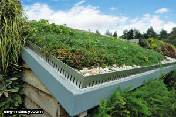Green Roofing Systems the Need of the Hour in Egypt 3 From 7

A study in Toronto found that two green roofs with minimal vegetation reduced peak summertime heat flow through the roof by 70% to 90% compared with a conventional roof on the same building.
Simulations also indicate cooling load
reductions from green roofs ranging from 1% to 25% depending on building specific Cs and characteristics of the green roof.
Green roofs work by shading roof surfaces and through evapotranspiration.
The plants of a green roof and the associated growing medium, a specially engineered soil, block sunlight from reaching the underlying roof membrane.
Shading reduces surface temperatures below the plants.
These cooler surfaces, in turn, reduce the heat transmitted into buildings or re-emitted into the atmosphere.
Plants absorb water through their roots and emit it through their leaves this movement of water is called transpiration.
Evaporation, the conversion of water from a liquid to a gas, also occurs from the surfaces of vegetation and the surrounding growing medium. Together, the processes of evaporation and transpiration are referred to as evapotranspiration.
Evapotranspiration cools the air by using heat from the air to evaporate water. Green roof temperatures depend on the roof’s
composition, moisture content of the growing medium, geographic location, solar exposure, and other site-specific factors.
Storm water Run-off
Healy rainfall can overwhelm any city’s sewerage and drainage systems causing raw sewage to be discharged into area waterways.
Depending on the planting type, soil depth and how saturated the system already is, a vegetative roof can absorb anywhere from 60 to 100 percent of the rainfall on its area.
The vegetative roof works by detaining and retaining the water.
Some of the water is taken up by the plants.



